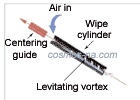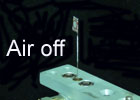
A Supersonic Air Wipe The levitating Vortex Demonstration of the Vortex in action
Click to enlarge

Air Wipe Introduction - the Supersonic Air Wipe
Air Wipes
Bow Guides
Eyelet Guides
Nozzle Guides
Pulleys
Ring Guides
Rods
Roller Guides
Snail Guides
Tube Guides
U- Guides
Welding Butts
Surface Finish
Glossary
Inquiry Forms
Materials
Site Map
Thank you for your visit. You are being redirected to an updated page.




What is a Supersonic Air Wipe?
When an aircraft travels beyond the speed of sound at sea level, 768 mph at 20o C, it qualifies as "a supersonic aircraft". Wind tunnels designed to characterize the behavior of supersonic aircrafts are able to create a supersonic air flow and in this context, an air wipe can be considered a miniature wind tunnel.
This miniature wind tunnel, if designed and employed properly, is capable of creating supersonic air flow that maximizes wiping efficiency and minimizes consumption of compressed air, thereby qualifying itself as a Supersonic Air Wipe. Two rules of Physics govern its performance.
The Basic Rules of Physics Governing Air Wipe Performance
Air wipes convert the Potential Energy of compressed air into Kinetic Energy by passing the air through constricting orifices obeying the Equation of Continuity, which states that the air velocity at a particular point within a flow tube is inversely proportional to the cross sectional area of the tube at that point.
Since Kinetic Energy = ½ M V2, it follows that when M or the air mass passing through the orifices remains constant, the Kinetic Energy is proportional to the square of the air velocity. Therefore, in an attempt to upgrade the performance of an air wipe, it is prudent to raise the air velocity instead of increasing the air flow, which adds to energy cost.
What goes into a Supersonic Air Wipe?
There are 2 velocity profiles in an air wipe:
Reducing the cross sectional area of the constricting orifices will theoretically raise the air velocity but there is a practical limit to this as it takes several small orifices to pass the same amount of air that goes through a large orifice. In addition, as the orifices shrink the frictional force amplifies, retarding the air flow into the air wipe.
On the other hand, it is more convenient to maintain a narrow gap (the space between the wire and the wall of the wipe cylinder) in an air wipe to raise the air velocity, provided the issue of wire damage due to friction has been addressed. This narrow gap approach is what the Supersonic Air Flow is based upon. The fundamental features incorporated in our air wipes to achieve this end are:
An Example
The air wipe shown at top left, cut away for clarity, is capable of cleansing a Ø 1.20 mm wire at supersonic air flow, while the wire travels at 900 meters/minute, consuming 0.233 liters/sec of compressed air. The Performance Data Sheet showing, among other parameters, the air velocities of this air wipe is depicted below:

What do we have to offer on Supersonic Air Wipes?
At this writing, we offer 2 versions of Vortex Air Wipes, all capable of Supersonic Air Flow:
Please see the respective pages for details.
Home AWM 51 AWM 61 Vortex and Evidence Air Wipe Replacement
Gap Dimensions and Performance How to Save Air Wiping Cost